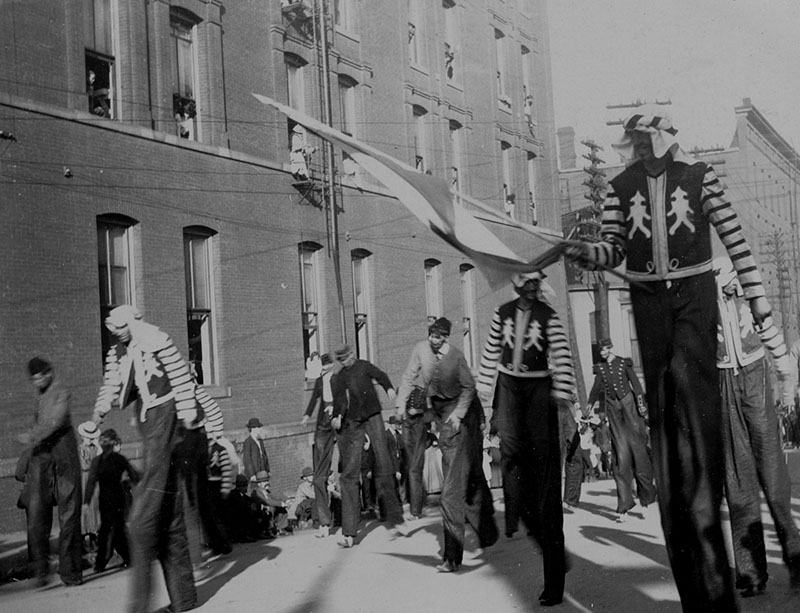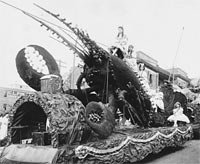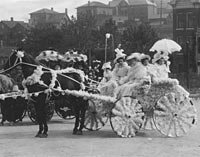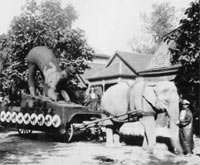A new Kansas City tradition emerged on October 13, 1887 with the first Priests of Pallas parade. President Grover Cleveland and his new bride, Frances, were on hand to witness the spectacle that would begin after nightfall. A crowd waited at the gates of the "Priests' Den," a warehouse where all of the horse-drawn floats were staged. As the doors swung open, fireworks lit the path of mounted and armored guards, the robed Priests of Pallas, and a float bearing the queen Athena, or rather, an elaborately-costumed performer.

Each year, Kansas City spared no expense in the public festival held in honor of Pallas (a pseudonym for the Greek goddess Athena). This unlikely theme had resulted from the organizers' desire to create a mystical atmosphere that would rival New Orleans's Mardi Gras in both spectacle and tourism revenues. These organizers were made up of young businessmen in the Flambeau Club, a civic promotional group that was initially led by a now obscure businessman named L.E. Irwin. They envisioned an annual parade and ball that would draw thousands of visitors and enliven the City Market area.
The details surrounding the first festival were kept secret, so that speculation and anticipation could build. The city's recognized elite were invited to a ball - by a mysterious stranger named "Jackson." When the parade finally arrived, spectators were dazzled by the queen "Pallas Athene," drummers, additional floats with ancient Greek themes, and even an elephant.
The attraction of the parade dovetailed with the presence of President Grover Cleveland, who had arrived the night before as part of a tour of the United States with his bride, Frances Folsom Cleveland. The 50-year-old Cleveland, who had been a bachelor when elected, had surprised the country in 1886 when he married Folsom, who was merely 21 years old. As much as Kansas Citians were curious about the secret Priests of Pallas plans, they equally anticipated a chance to see the new First Lady of the United States.
Every subsequent October, the Priests of Pallas organizers struggled to outdo the previous year's festivities. The exact details of each parade are unclear, but the festival usually consisted of a three day event made up of three parades and a ball for those lucky enough to receive an invitation from "Jackson." The first night's parade consisted of a military march and a procession of the 100-plus men of the Flambeau Club. These businessmen launched Roman candles over the crowds that lined the streets. On the second night, members of the city's labor unions marched with the accompaniment of bands. On the third night, the Grecian-themed parade was held. The ball commenced after Athena had received her laurels on the night of the third parade.
To keep the entertainment fresh year after year, the theme of the parade changed. Some of these themes included Grecian Myths, Parade of Nations, American History, Romance of the Ages, Prose and Poetry, Mother Goose, A Trip to Mars, and the Animated Circus Parade. But what really attracted spectators was not the rotating themes (which were often haphazardly applied and confusing in presentation), but rather the elaborate floats. The floats evolved from relatively simple horse-drawn affairs into elephant-drawn or bicycle-powered floats with electric lights, decorated streetcars, and eventually automobiles. Many floats resembled exceedingly large animals, Greek gods, steamships, or other impressive displays.
By 1913, the Priests of Pallas had lost some of its luster. Many had come to believe that the extravagant spectacles were tacky. In the end, the festival's expense doomed it. The 1913 parade was cancelled due in large part to difficulty in finding a business willing to accommodate the "Den" that housed many of the floats. After a nine-year absence, the final two Priest of Pallas parades were held in 1922 and 1923. George M. Myers, the president of the new Priests of Pallas organization, offered $500 to anyone who could reveal the identity of "Jackson." No one came forward, and Jackson remained a mystery. Today, no one knows for certain who Jackson was, but a leading theory is that the name was inspired by Charles A. Jackson, a black custodian who worked for the Kansas City Commercial Club.
The 1922 and 1923 revivals came up short, and the Priests of Pallas tradition ended. Today, however, there is considerable interest in reviving the spirit and some traditions of the Priests of Pallas. In October, 2005, a Priests of Pallas masquerade ball was put on by the Jackson County and Westport historical societies at Union Station. They adhered to unique Priests of Pallas traditions, such as designing special souvenirs specific to each year. While it has yet to draw crowds of 500,000 to rival the original Priests of Pallas parades, the new version was successful enough to be repeated in 2006 and 2007.
Read full biographical sketches of organizers of the Priests of Pallas parade, prepared for the Missouri Valley Special Collections, the Kansas City Public Library:
- Uriah Epperson (1861-1927) and Mary E. Epperson (1855-1939), philanthropists, by Daniel Coleman; Uriah Epperson served as the president of the Fall Festival Association, which put on some of the Priests of Pallas parades.
View images of the Priests of Pallas parade that are a part of the Missouri Valley Special Collections:
- Priests of Pallas, Diamond Veil postcard
- Elephant-drawn Priests of Pallas parade float, 1895
- Priests of Pallas parade float with oversized lobster, 1905
- Priests of Pallas parade float with electric lights and a large eagle, 1905
- Bicycle-powered Priests of Pallas parade float, 1897
- President Grover Cleveland in KC, October 1887
- President Grover Cleveland in KC, October 13, 1887
- Man on stilts
- People in costume for the Priests of Pallas
- Costumed Women on Horseback, 1895
- Man with bicycle at the parade
- Men and Children with Horses, 1895
- Men Marching in Formation, 1895
- Onlookers and Floats, 1897
- Parade Archway, 1895
- Parade Participants on Horseback, 1895
- People in Decorated Car, 1905
- Priests of Pallas Parade Carriage, 1905
- Priests of Pallas Commemoration Plaque, 1906
- Postcard of the Coates House Hotel; where President Grover Cleveland and his wife viewed the first Priests of Pallas parade
Check out the following books and articles about the Priests of Pallas parade, held by the Kansas City Public Library:
- "When Priests of Pallas Made the City Festive," in The Kansas City Times, October 17, 1963.
- "Return of the Priests of Pallas--The Most Spectacular Party in KC History," by Leigh Elmore, in KC Magazine, October 1, 2005.
- "Priests of Pallas: Kansas City's Forgotten Fall Festival," by Thomas M. Spencer, in the Jackson County Historical Society Journal, autumn, 2003.
Continue researching the Priests of Pallas parade using archival material held by the Missouri Valley Special Collections:
- Priests of Pallas Collection Finding Aid; the most complete collection of documents and artifacts pertaining to the Priests of Pallas.
- Vertical File: Priests of Pallas.
- Microfilm: Native Sons Scrapbooks, Roll 58: Priests of Pallas.
- Mounted Clipping File: Priests of Pallas; newspaper clippings.
- Microfilm: Kansas City Star & Times Selected Subjects, Roll 87: Priests of Palace.
- Manuscript File: Bryan, Craig; "The Priests of Pallas Parade and Ball: Kansas City, Missouri, 1887-1924," by Craig Bryan, 52 page manuscript.
- Microfilm: Native Sons Scrapbooks, Roll 58; Karnival Krewe; activities that coincided with the Priests of Pallas Parade.
- William Weber, artist; collection contains photographs of Priests of Pallas memorabilia.
References:
Henry Van Brunt, "When Priests of Pallas Made the City Festive," The Kansas City Times (October 17, 1963).
Dory DeAngelo, What About Kansas City!: A Historical Handbook (Kansas City, MO: Two Lane Press, 1995), 120-122.
Henry C. Haskell, Jr., and Richard B. Fowler, City of the Future: A Narrative History of Kansas City, 1850-1950 (Kansas City, MO: Frank Glenn Publishing, 1950), 59-61.
Sherry Lamb Schirmer, At the River's Bend: An Illustrated History of Kansas City: Independence and Jackson County (Woodland Hills, CA: Windsor Publications, 1982), 152-153.
Rick Montgomery & Shirl Kasper, Kansas City: An American Story (Kansas City, MO: Kansas City Star Books, 1999), 131.




